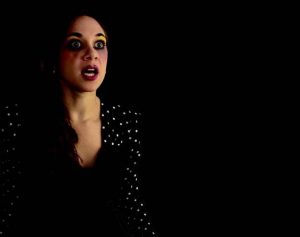

Joey Merlo’s The Witch of St. Elmora Street centers on Michelangelo (Chris Dunlop) and his twin sister, Graziella (Caitlin Zoz), and it is introduced by a talking tomato plant invested with the spirit of their father, an Italian immigrant who credits their twinhood to their mother drinking the milk of a cow that had earlier that same year given birth to twin calves. Now grown, Michelangelo, or Mickie, has just lost his wife, Vicky (Vanessa Koppel), to Mimo (Chinaza Uche), who was, up to that point, Graziella’s lover, and Graziella, unable to account for this, fed on rumors and a fortune teller’s prophecies, suspects that Vicky is a witch who has stolen Mimo with a spell that involves putting her period blood in his espresso every day ntil the full moon. Though this might sound like a tale from the old country, it’s New Jersey circa 1987. Mickie’s gone slightly mad, and a desire for revenge is bubbling up in Graziella’s heart. Which makes sense, since the fortune teller also told Graziella that there will be “Blood! Blood! Blood!”
In one respect, the title of this play is somewhat misleading, as it is more or less a collateral question whether or not Vicky is a witch and whether or not she stole Mimo with a spell. But, on the other hand, the title is more than apt enough, as it is the lens of superstition that in the main shapes these characters’ worldview. It is an intriguing framework because, through those superstitions, we discover not only the hinges of the story on the stage, but also threads of continuity tying the characters to a deep and rich familial history and wide cultural heritage. And, whether or not there is witchcraft to blame for the connubial crises in question, there is undeniably a fair bit of magic at play in this particular narrative, given to life, perhaps, by those dangerous seeds of superstition.
Indeed, that’s really wherein lies the true charm of Merlo’s play, for, infused into the general sense of impending doom, there is an overall warmth that feels genuine. The myths that these Italian-Americans harbor instill elements of the tragic into their lives, providing vehicles for their damaged emotions to drift into violence and madness, but those very same myths provide a sense of actual and spiritual community that allows this story to transform into a kind of modern folk tale, which, as many good folk tales do, provides a coping mechanism for hard times. As such, despite the tragic elements, the happenings on St. Elmora Street are free to reveal themselves in the realm of comedy.
There are moments when The Witch of St. Elmora Street seems to be stretching itself a bit too far, trying to do a bit too much, but one of its finest qualities is that it frequently achieves a nearly grotesque clownishness without depriving its characters, or its audience, of a sense of realness in their sentiments and actions, no matter what myths they draw upon to dress them in.